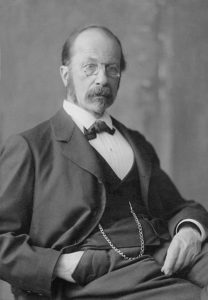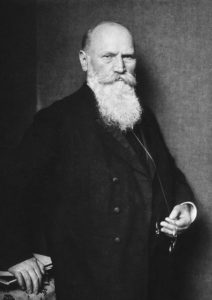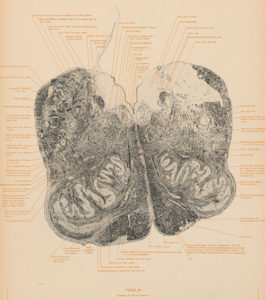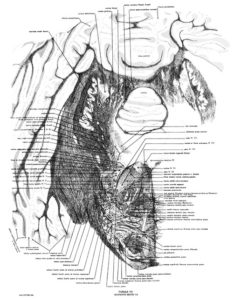Although often considered a predecessor of the International Brain Research Organization (IBRO, founded in 1961), the International Brain Commission (founded in 1903) played an important role in the history of neurology and its international organization. After all, many early brain researchers often were seeing patients with neurological or neuropsychiatric diseases, and the distinction between clinical and laboratory work was perhaps less evident.

Wilhelm His (1831-1904)
In 1899, leading European academies and scientific societies, in cooperation with the Washington, DC, Academy, joined efforts and founded the International Association of Academies (IAA). International cooperation was considered important in several fields of science, including geophysics and astronomy.
In 1903, the Central Commission for Brain Research, usually abbreviated as Brain Commission, was constituted in London. The IAA had accepted a motion, proposed by the Swiss-German (neuro)anatomist Wilhelm His (1831-1904) to this purpose a few years earlier, stating that the IAA:

Wilhelm Waldeyer (1836-1921)
Should set up a Special Commission to consider the ways and means of achieving the collection, preparation, and general utilization of reliable material for observation on the basis of common principles in the field of human and animal evolution, on the one hand, and on brain anatomy on the other (Richter, 2000).
The first part of the motion was dropped at the London meeting, limiting the purpose to brain research. The formulation accepted by the Brain Commission finally stated:
The several Academies and Societies, represented in the Association, should bring by the name of the Association before their respective governments, or other appropriate authorities, a proposal to establish special institutions of departments of institutions, for the investigation of the Central Nervous System, where such organizations are not already in existence or cannot be created otherwise (Richter, 2000).

Plate from the Swiss part of the International Brain Atlas (1916)
An important motivation was the time-consuming preparation of numerous serial brain sections for comparative neuroanatomic research, in which an international cooperation would be advantageous. A comparison was made with the cooperation in setting up an international network of astronomical observatories. The establishment of neuroanatomical research institutes was promoted with the purpose of providing brain banks and archives of histological preparations. The Constitution and Bye Laws of the Brain Commissions had 36 items, including one on the recognition of an institute:
Should an Institute desire to be recognized as an Interacademic Institute for Brain Study… application for this must be made to the President of the Central Commission. To the petition are to be added statements of the plan of work, organization, personnel, and financial resources. Action on this petition will be taken at the next regular meeting of the Central Commission. A simple majority of the members present decides, the President voting in case of a tie.
The Dutch neurologist Cornelis Winkler (1855-1941) wrote in his recollections that “they hoped, by influence from the academies, to convince the various governments of the importance of joint international work in this area and to motivate them to found central institutes for brain research,”
and the Swiss Constantin von Monakow (1853-1930) wrote in his Vita Mea that the “most important task,” announced by the IAA would be the “mutual scientific assistance and cooperation and if possible methodic organization of brain research.” He hoped that the “mischief of brain research” with “lack of any organization, chaos concerning research and publications” would be reduced. The Swedish Salomon E. Henschen (1847-1930) was rather critical about the Brain Commission in his autobiography, and the German Paul Flechsig (1847-1929) was not satisfied about the lack of scientific fruitful ideas.
Well-Known Brain Scientists

Plate from the Dutch part of the International Brain Atlas (1929)
Wilhelm His became the first president of the Brain Commission, and upon his death in 1904, was succeeded by Wilhelm Waldeyer (1836-1921). The first nine interacademic institutes for brain research were soon acknowledged (1904-1912). The institutes were directed by well-known brain scientists, including Santiago Ramón y Cajal (Madrid, 1904), Paul Flechsig (Leipzig, 1904), Ludwig Edinger (Frankfurt am Main, 1904), Heinrich Obersteiner (Vienna, 1906), Constantin von Monakow (Zurich, 1906), Henry H. Donaldson (Philadelphia, 1906), Vladimir M. Bekhterev (St. Petersburg, 1908), Cornelius U. Ariëns Kappers (Amsterdam, 1909), and Károly Schaffer (Budapest, 1912).
The first three of this list (Madrid, Leipzig, and Frankfurt am Main) were already existing institutes for the study of the central nervous system. Monakow’s Zurich institute and the Wistar Institute in Philadelphia were recognized in 1906. At least four Brain Research institutes owed their existence to the Brain Commission, including the Central Institute for Brain Research in Amsterdam, the Brain-Histological Institute in Budapest, and Bekhterev’s Psychoneurological Institute in St. Petersburg (Richter, 2000). Obviously, not every country was endowed with this honor, and it was prestigious to be elected head of an institute.
The Brain Commission had seven special subcommittees, including macroscopic morphology and phylogenetic research. Up to 1914, over 50 well-known “neuroscientists,” including physiologists, had become members, of whom three became Nobel Laureates, notably Golgi, Cajal, and Sherrington. Led by Waldeyer, a new nomenclature of brain-anatomical terms was set up by the Brain Commission.
International Brain Atlas
In the correspondence between Winkler and Monakow, kept in Amsterdam and Zurich (207 letters), activities of the Brain Commission were often subject of discussion. Winkler wrote to Monakow that subsequent to the planned neurology congress in September 1914 in Bern, he, in his function as member of the Brain Commission, intended to visit laboratories in Copenhagen, Kiel, and Hamburg to judge whether they would be eligible to become interacademic brain institutes. He also hoped to be able to receive Dutch grants for the International Brain Atlas project (Winkler to Von Monakow, July 26, 1914), a project initiated in particular by Waldeyer and Edinger.
More Reading
Holdorff B. Salomon Henschen’s short-lived project of an “Academia Neurologica Internationalis” (1929) for the revival of the International Brain Commission: documents from the Cécile and Oskar Vogt archives. J Hist Neurosci 2011; 20: 93–105.
Jagella C, Koehler PJ. The International Brain Commission (1903–1914): Dutch and Swiss Perspective (Toward Neurosciences Beyond Borders). Clinical & Translational Neuroscience 2018;1:1–10.
Koehler PJ, Jagella C. The correspondence between Winkler and Monakow during World War I. Eur Neurol. 2015;73:66-70
Monakow C von. Zur Frage nach Neugründung der “brainkommission” (internationale Hirnkommission) und einer international organisierten Hirnforschung. Schweiz Arch Neurol Psychiatr 1929; 24: 3–9.
Richter J. The brain commission of the international association of academies: the first international society of neurosciences. Brain Res Bull. 2000;52:445-57.
This ambitious project was not successful, however, because of WWI. Moreover, an important disadvantage of such a project became evident. There were too many differences between the Zurich (made by Gennosuke Fuse [1880-1946] and Von Monakow) and Amsterdam contribution (made by Ada Potter [1878-1961] and Winkler). Nevertheless, the Zurich part of the microscopic atlas on the medulla oblongata was published in 1916. With respect to the Amsterdam part, Winkler met with several problems and was looking for help from abroad: “Would it be possible that [Frederick] Mott and [Ludwig] Edinger and Pierre Marie also take care of drawing some of the plates?” (correspondence of Winkler to Monakow, Oct. 16, 1919). Furthermore, he wrote in the 1929 preface, “The war was the cause of financial obstacles, opposing themselves to the printing of the second volume, that had been drawn in Holland. There were so many that the publication of the second volume of the atlas was postponed from year to year. At the moment when the Royal Academy of Sciences was able to give a solution to the financial difficulties, in 1929, the second volume of the atlas was published.”
Collapse and Attempts of Reanimation
The Brain Commission more or less collapsed after the outbreak of WWI, and in January 1919, Winkler wrote to Monakow: “Wouldn’t it be time that you, Ramón y Cajal, and me attempt to bring together the Brain Commission again?” (correspondence of Winkler to Von Monakow, Jan. 10, 1919). The subject lapsed until 1927, when Monakow (then 74 years old) in his correspondence with Winkler (at age 72) expressed his regret that (Frederic) “Mott cannot be moved to install this again.” Furthermore, in 1927, Winkler asked two of his Dutch colleagues in Amsterdam, Cornelius U. Ariëns Kappers, director of the Amsterdam Brain Institute, and Bernard Brouwer, professor of neurology, to use their positions to help resuscitate the Brain Commission (correspondence of Winkler to Von Monakow, April 19, 1927).
Several more letters were exchanged between Monakow and Winkler to discuss resurrection of the Brain Commission. (See Jagella and Koehler, 2018.) The Swedish Henschen (then 82 years old; he had been consulted by Lenin, who had suffered a stroke, six years previously, with Foerster, Nonne, Bumke, and Strümpell), from his side, also made attempts to revive the organization, proposing the name Academia Neurologica Internationalis. (See Holdorff, 2011.) He received endorsements from Mingazzini, Cushing, Minor, Elliott Smith, and Pavlov.
In his correspondence with Cécile Vogt, he proposed to hold a conference in Amsterdam or Utrecht, but later changed to Stockholm. Eventually, neither of the proposals succeeded. In the meantime, a number of younger neurologists were preparing an International Congress of Neurology to be held in Berne, Switzerland (where the 1914 meeting had been cancelled due to the outbreak of WWI) in 1931. (See World Neurology 2018;33:no.1.) The reanimation of the Brain Commission had failed. •
